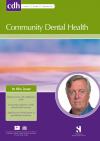Community Dental Health

- Cover Date:
- September 2014
- Print ISSN:
- 0265 539X
- Vol:
- 31
- Issue:
- 3
Experience of racism and tooth brushing among pregnant Aboriginal Australians: exploring psychosocial mediators
Community Dental Health (2014) 31, 145–152 Received 11 September 2013; Accepted 7 February 2014
© BASCD 2014 doi:10.1922/CDH_3298Ben08
Experience of racism and tooth brushing among pregnant Aboriginal Australians: exploring psychosocial mediators
Objectives: Despite burgeoning evidence regarding the pathways by which experiences of racism influence health outcomes, little attention has been paid to the relationship between racism and oral health-related behaviours in particular. We hypothesised that self-reported racism was associated with tooth brushing, and that this association was mediated by perceived stress and sense of control and moderated by social support. Methods: Data from 365 pregnant Aboriginal Australian women were used to evaluate tooth brushing behaviour, sociodemographic factors, psychosocial factors, general health, risk behaviours and racism exposure. Bivariate associations were explored and hierarchical logistic regression models estimated odds ratios (OR) and 95% confidence intervals (CI) for tooth brushing. Perceived stress and sense of control were examined as mediators of the association between self-reported racism and tooth brushing using binary mediation with bootstrapping. Results: High levels of self-reported racism persisted as a risk indicator for tooth brushing (OR 0.51, 95%CI 0.27,0.98) after controlling for significant covariates. Perceived stress mediated the relationship between self-reported racism and tooth brushing: the direct effect of racism on tooth brushing was attenuated, and the indirect effect on tooth brushing was significant (b coefficient -0.09; biascorrected 95%CI -0.166,-0.028; 48.1% of effect mediated). Sense of control was insignificant as a mediator of the relationship between racism and tooth brushing. Conclusions: High levels of self-reported racism were associated with non-optimal tooth brushing behaviours, and perceived stress mediated this association among this sample of pregnant Aboriginal women.. Limitations and implications are discussed.
Key words: racism, toothbrushing, psychosocial factors, psychological stress, control, Australian Aborigines
- Article Price
- £15.00
- Institution Article Price
- £0.00
- Page Start
- 145
- Page End
- 152
- Authors
- J. Ben, L.M. Jamieson, N. Priest, E.J. Parker, K.F. Roberts-Thomson, H.P. Lawrence, J. Broughton, Y. Paradies
Articles from this issue
- Title
- Pg. Start
- Pg. End
- Experience of racism and tooth brushing among pregnant Aboriginal Australians: exploring psychosocial mediators
- 145
- 152
- Dietary intake of calcium, vitamins A and E and bleeding on probing in Sri Lankan preschoolers
- 153
- 157
- Type II diabetes and oral health: perceptions among adults with diabetes and oral/health care providers in Ghana
- 158
- 162
- Access, literacy and behavioural correlates of poor self-rated oral health amongst an Indigenous South Australian population
- 167
- 171
- Evaluation of a capacity building clinical educational model for oral health clinicians treating very young children
- 176
- 182
- The significance of motivation in periodontal treatment: The influence of adult patients’ motivation on the clinical periodontal status
- 183
- 187
